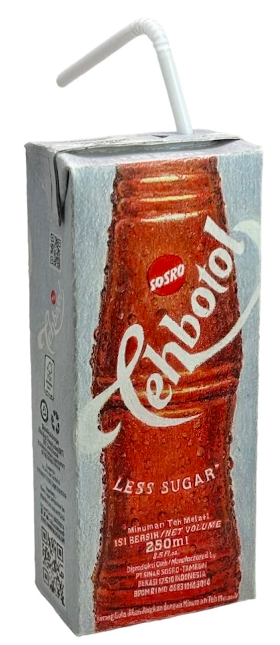(A+ Works of Art) Tehbotol, 2024
Kentaro Hiroki
Kentaro Hiroki’s meticulous recreation of found objects is a study in material culture. The biography of things—popular consumer products of particular demographics, national documents—is an entry point into understanding how objects become entangled in the personal and the political. For the Japanese artist living and working in Bangkok, this interest arises from his unique position as an outsider both in his current abode and back home. Scrutinising the found objects in his vicinity, finding traces of time and ownership in stains and creases, is a practice of understanding how communities make meaning out of their object worlds. Concurrently, Hiroki is studying these objects with an eye for design principles, an interest informed by his role as a Design educator in Bangkok. Decoding the hidden systems and ratios that define a product’s design is a way to understand how different cultures make, see, and consume. The focus on foodstuff in this presentation samples the artist’s frequent interest in recreating foodstuff, as objects that are deeply intertwined with our social status, cultural backgrounds and personal tastes. For individuals living outside their home country, certain food products can also serve as potent symbols of cultural identity and nostalgia, acting as touchstones to connect with one’s roots and sense of self. In this way, the foods we buy and consume can serve as powerful mnemonic devices, triggering memories and emotions associated with our cultural heritage. Hiroki’s recreation of these objects on paper can be viewed as a form of cultural exchange, in which the outsider artist seeks to connect to his audience by offering a gesture of familiarity. His recreation of an Indomie packet for Art Jakarta 2023 was a starting point for his efforts to connect to an Indonesian audience. At the same time, by uncovering their biographical quirks, as the receiver we are encouraged to take note of the objects that we take for granted from an outsider’s perspective. The process of cultural exchange can be a tense one, and in that tension, we can unpack the reasons for why we may become tetchy from the translation of our cultural stories and representatives.
